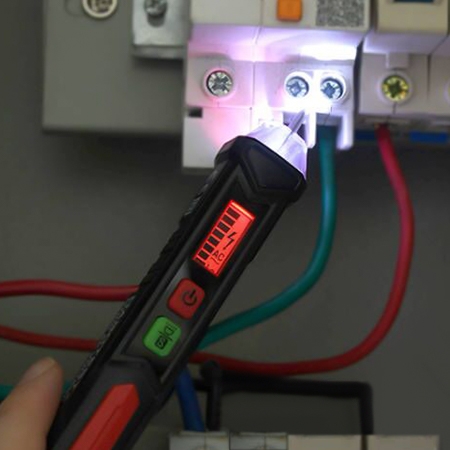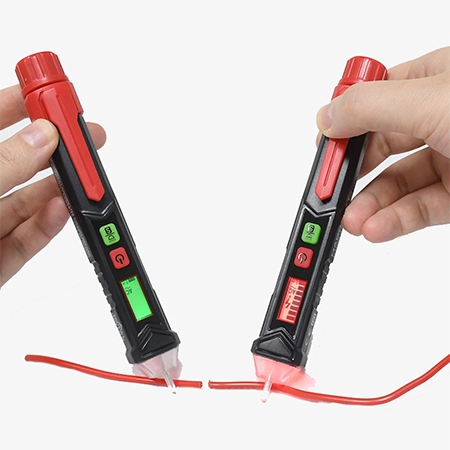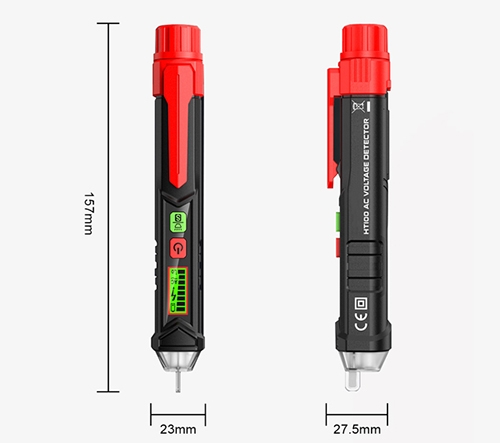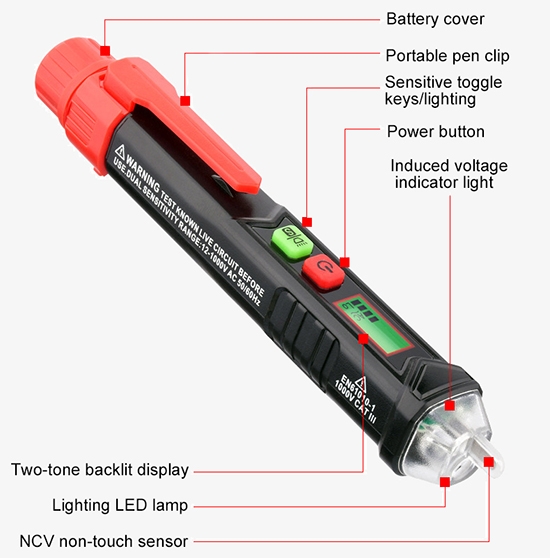The contactless AC voltage tester pen for sale online. 12-1000V AC voltage detector can easily distinguish the live and null wire through different levels of alarm sound and LED indicator. Just put the tip of the non-contact voltage tester near the terminal board, socket, or power cord, they can intelligently identify live/null wire and breakpoint.

The AC voltage tester design with a LED flashlight lighting
- LED flashlights enhance visibility in dark or low-light environments, making it easier to see the voltage tester's readings or indicators.
- Using an LED flashlight helps accurately locate wires, outlets, or switches, ensuring the voltage tester’s probes are properly aligned with the test points.
- Adequate lighting speeds up the process and makes testing more efficient in dimly lit environments.

Breakpoint finder function
- Voltage detectors are ideal for quickly identifying breaks or faults in electrical circuits, helping to locate the exact point of failure.
- By testing different points along a circuit, a voltage tester helps you systematically isolate and identify where the break or fault is occurring.
- Voltage tester pens help ensure that you are only working on de-energized sections of the circuit during repair, minimizing the risk of electric shock while identifying circuit breaks.
Dimension

Applications
SISCO voltage testers are essential tools used in electrical work to determine the presence and level of electrical voltage in circuits and devices. They help ensure safety by allowing electricians and DIY enthusiasts to verify that circuits are de-energized before performing maintenance or installations. Common applications include residential and commercial electrical work, industrial settings, automotive industry, telecommunications, HVAC systems, utilities and power distribution, and renewable energy systems, where they check outlets, wiring, machinery, vehicle electrical systems, communication equipment, HVAC units, power lines, and renewable energy installations for proper voltage and functionality.

Automotive Industry

Telecommunications

HVAC Systems

Commercial Electrical Work
| Model | SISCO-VT-HT100 |
| Measuring Voltage | High sensitivity: AC 12-1000V; Low sensitivity: AC 48-1000V |
| Display | Simulation bar |
| Frequency | 50/60 Hz |
| Alarm mode | Sound and light alarm |
| Probe shape | Oblate shape |
| Neutral and live wire judgment | According to the backlight color change: Green is neutral wire, and red is live wire |
| Signal Strength Display | Four-level sensitivity of bar graph |
| Signal Strength Indication Method | Sound from slow to fast; Backlight from green to red; Bar graph from low to high |
| Automatic shutdown | √ |
| Flashlight | √ |
| Safety level | EN61010-1, -2-030, EN61326-1, CAT Ⅲ 1000V |
| Dimensions | 157*27.5*23mm |
| Weight | 50g |
Detail

Q1: What is a voltage tester?
A1: A voltage tester is a tool used to determine the presence and level of electrical voltage in a circuit or device. It helps to ensure safety by allowing users to verify if circuits are live (energized) or de-energized before performing electrical work.
Q2: What are the types of voltage testers?
A2: There are various types of voltage testers, including:
- Non-Contact Voltage Testers (NCVT): Detect voltage by sensing the electric field around a live conductor without making physical contact with it. They usually indicate the presence of voltage through a light, sound, or vibration.
- Contact Voltage Testers: Require direct contact with the conductor to measure voltage. They typically have probes or leads that need to touch the wires or terminals being tested.
- Analog Voltage Testers: Use a needle gauge to show voltage levels. These are less common today but still used in some applications.
Q3: What is the importance of the sampling rate in an AWG?
A3: If your voltage tester isn't detecting voltage, check the following:
- Battery: Replace it if it’s dead.
- Settings: Ensure it’s set to the correct mode and range.
- Tester Condition: Test it on a known live circuit to verify if it’s working.
- Use: Make sure you’re using it correctly and making good contact.
- Power: Verify that the circuit is actually live and turned on.
Tips: How to maintain a voltage tester?
Maintaining a voltage tester is essential to ensure its accuracy, reliability, and safety. Here are some key steps to properly maintain your voltage tester:
- Regularly Inspect the Tester: Look for any visible damage to the tester's body, probes, or leads, such as cracks, frayed wires, or worn insulation. Ensure the probe tips are not bent, corroded, or damaged, as this can affect the accuracy of readings.
- Keep It Clean: Use a soft, dry cloth to clean the tester after each use. Avoid using harsh chemicals or solvents that could damage the plastic housing or display. Ensure that the connection points, such as probe sockets, are free from dust and debris that might interfere with proper contact.
- Check and Replace Batteries: Regularly check the battery status, as a low battery can lead to inaccurate readings or device failure. Replace as Needed: Replace the batteries promptly when the tester indicates low battery power or if performance seems compromised.
- Proper Storage: Keep the voltage tester in a protective case or a dry, cool place to avoid exposure to moisture, dust, or extreme temperatures, which could damage the internal components. Do not store the tester under heavy objects or in tight spaces where it might be crushed or deformed.
Thank you for buying industrial test and measurement equipment on SISCO.com, all products sold by SISCO and the partner cover a 12 months warranty, effective from the date of receiving the products.
What is covered?
SISCO is responsible for providing free spare parts, and free technical support to assist the customer to repair the defective products until the problem is solved.
What is not covered?
- Product purchased from anyone other than a SISCO store or a SISCO authorized reseller.
- Expendable parts.
- Routine cleaning or normal cosmetic and mechanical wear.
- Damage from misuse, abuse or neglect.
- Damage from use of parts other than SISCO approved.
- Damage from use outside the product’s usage or storage parameters.
- Damage from use of parts not sold by SISCO.
- Damage from modification or incorporation into other products.
- Damage from repair or replacement of warranted parts by a service provider other than a SISCO authorized service provider.
- Damage caused by the application environment not meeting the product usage requirements and the failure to perform preventive maintenance.

